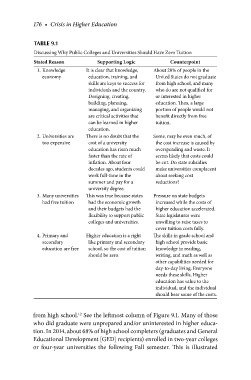Page 205 - Crisis in Higher Education
P. 205
176 • Crisis in Higher Education
TABLE 9.1
Discussing Why Public Colleges and Universities Should Have Zero Tuition
Stated Reason Supporting Logic Counterpoint
1. Knowledge It is clear that knowledge, About 20% of people in the
economy education, training, and United States do not graduate
skills are keys to success for from high school, and many
individuals and the country. who do are not qualified for
Designing, creating, or interested in higher
building, planning, education. Thus, a large
managing, and organizing portion of people would not
are critical activities that benefit directly from free
can be learned in higher tuition.
education.
2. Universities are There is no doubt that the Some, may be even much, of
too expensive cost of a university the cost increase is caused by
education has risen much overspending and waste. It
faster than the rate of seems likely that costs could
inflation. About four be cut. Do state subsidies
decades ago, students could make universities complacent
work full-time in the about seeking cost
summer and pay for a reductions?
university degree.
3. Many universities This was true because states Pressure on state budgets
had free tuition had the economic growth increased while the costs of
and their budgets had the higher education accelerated.
flexibility to support public State legislatures were
colleges and universities. unwilling to raise taxes to
cover tuition costs fully.
4. Primary and Higher education is a right The skills in grade school and
secondary like primary and secondary high school provide basic
education are free school, so the cost of tuition knowledge in reading,
should be zero. writing, and math as well as
other capabilities needed for
day-to-day living. Everyone
needs these skills. Higher
education has value to the
individual, and the individual
should bear some of the costs.
from high school. See the leftmost column of Figure 9.1. Many of those
12
who did graduate were unprepared and/or uninterested in higher educa-
tion. In 2014, about 68% of high school completers (graduates and General
Educational Development [GED] recipients) enrolled in two-year colleges
or four-year universities the following Fall semester. This is illustrated

